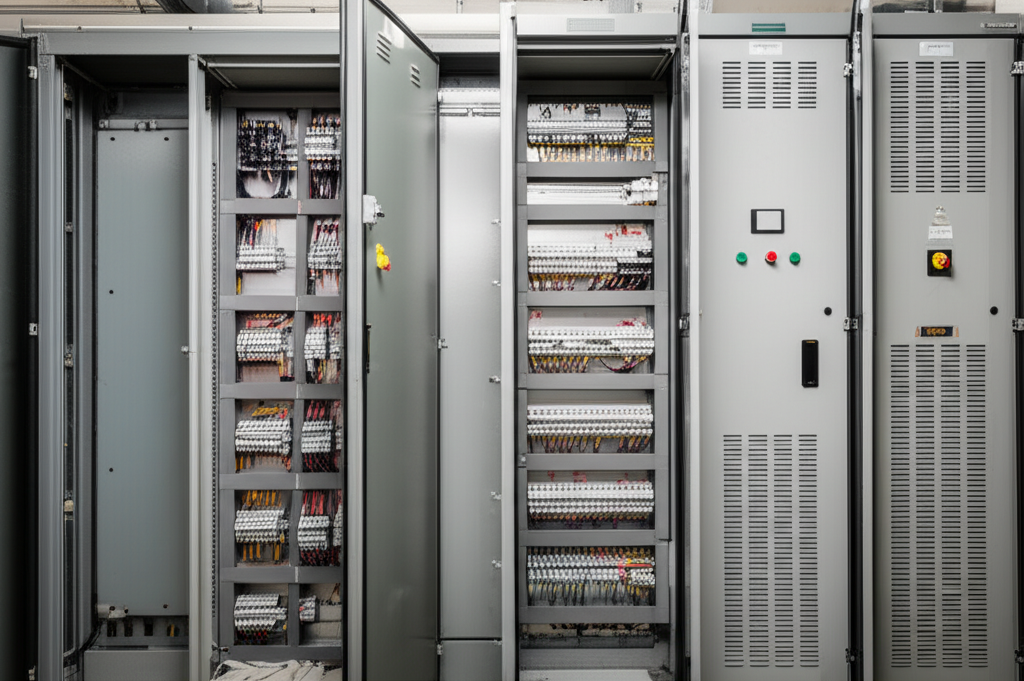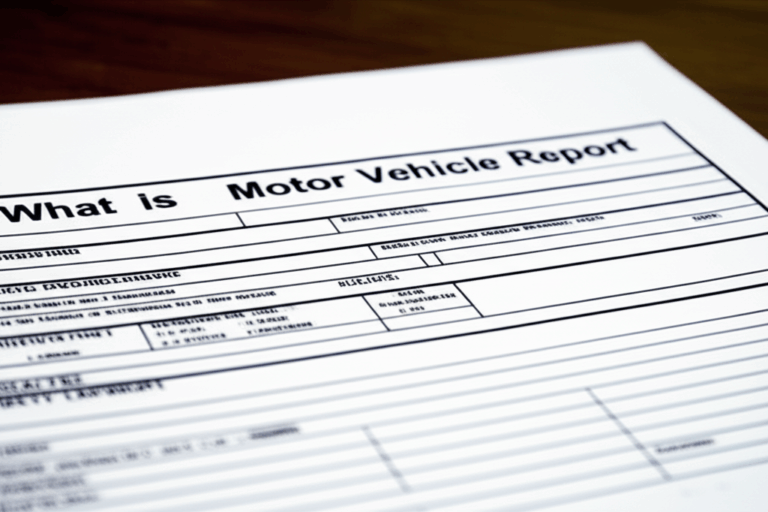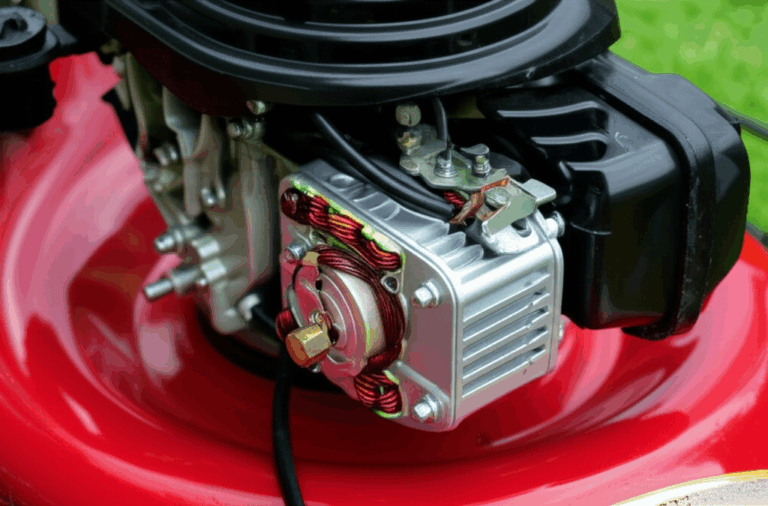
What Is a Motor Control Centre (MCC)? My Complete, Practical Guide
Table of Contents
- Introduction: How I Learned to Love MCCs
- What Is a Motor Control Centre (MCC)?
- Why Industries Use MCCs: The Real Purpose
- Inside the Box: Core Components and Structure
- Vertical Sections and Cubicles
- Busbar System: Horizontal and Vertical
- Motor Starter Units (Buckets)
- Integrated Devices: VFDs and Soft Starters
- Automation and Monitoring: PLC, HMI, SCADA
- Incoming Line Section and Power Distribution
- Grounding and Earthing
- How an MCC Operates: Power, Control, and Protection
- Power Flow
- Control Logic: Manual, Automated, and Remote
- Protection: Overcurrent, Short Circuit, Thermal, and More
- SCADA and DCS Integration
- Types of Motor Control Centres
- Fixed Type MCC
- Withdrawable Type MCC
- Intelligent MCC (iMCC)
- Where MCCs Live: Common Applications and Industries
- The Big Benefits: Advantages of Using MCCs
- The Catch: Considerations and Potential Disadvantages
- Safety and Compliance: Standards That Matter
- Design and Specification Tips That Have Saved Me Headaches
- Control Voltage vs Power Voltage
- Cooling and IP/NEMA Ratings
- Indoor vs Outdoor
- Seismic and Hazardous Area Considerations
- Harmonics and Power Factor
- Maintenance and Troubleshooting: What Works in the Real World
- MCC vs PCC vs Switchgear: Clearing the Confusion
- The Future: Smart, Connected, Efficient
- Final Thoughts: Why MCCs Still Matter
Introduction: How I Learned to Love MCCs
When I first walked into a noisy plant room and stared down a forty-foot lineup of grey doors with pilot lights blinking like a runway, I felt two things. Curiosity and respect. Someone once told me that a Motor Control Centre is like a city hall for your motors. Everything key runs through it. Over the years I’ve planned projects around them, commissioned new lineups, troubleshot nasty faults, and helped teams justify upgrades. I’ve learned what works, what breaks, and why a good MCC makes a plant feel calm even when everything else is moving fast.
This guide pulls together those lessons. I’ll explain what an MCC is, what sits inside, how it works, which types you should consider, how to stay safe, and where the tech is heading. I’ll keep it practical. I’ll keep it honest. Let’s open the doors.
What Is a Motor Control Centre (MCC)?
An MCC or Motor Control Centre is a centralized electrical panel system that organizes, protects, and controls multiple electric motors in one place. You might also see it spelled Motor Control Center. Same thing. Think of it as a modular lineup of compartments where each “bucket” controls a motor or a group of loads like pumps, fans, conveyors, and compressors.
In plain terms:
- Power comes in through a main section.
- Busbars distribute that power along the lineup.
- Individual motor starter units handle start, stop, protection, and sometimes speed control.
- Control and automation devices handle logic and communication.
You’ll find low voltage MCCs in most manufacturing plants. You’ll see medium voltage MCCs where big motors live. If a facility uses many motors and values safety, uptime, and clean wiring, it likely has an MCC.
Why Industries Use MCCs: The Real Purpose
Three reasons keep coming up for me:
1) Organization and safety: You get a clean, centralized layout with consistent protection. Operators and maintenance teams know where to go.
2) Reliability and uptime: Withdrawable buckets, clear wiring, and proper protection reduce downtime.
3) Control and efficiency: VFDs, soft starters, PLCs, and metering help you run motors smarter. That translates to energy savings and longer motor life.
A good MCC also makes expansion easier. You add another bucket or two instead of tearing open junction boxes across the plant. That alone reduces chaos on project day.
Inside the Box: Core Components and Structure
Vertical Sections and Cubicles
I look at an MCC as a series of vertical sections housing multiple compartments. Each compartment holds a feeder or starter. The layout is modular. That makes design, installation, and maintenance predictable.
Busbar System: Horizontal and Vertical
The busbar system forms the backbone. You’ll see:
- Horizontal busbars that bring power across the lineup.
- Vertical busbars that feed each section.
Designers size busbars for load and short circuit duty. They shield or segregate them to improve safety and reduce the chance of faults jumping between sections.
Motor Starter Units (Buckets)
Each motor usually gets its own “bucket.” Inside a typical low voltage motor starter you’ll see:
- Short-circuit protection: Fuses, MCCBs, or TMCBs.
- A contactor: The switching workhorse.
- An overload relay: For thermal protection.
- Control circuitry: Push buttons, selector switches, pilot lights, timers, and interlocks.
Common starter types include:
- Direct On Line (DOL) starter for simple, robust applications.
- Star-delta starter to reduce inrush on larger motors.
- Soft starter for smoother starts with less mechanical stress.
- Combination starter that integrates protective devices and contactor in one package.
I always label buckets clearly and keep schematics updated. A tidy drawing saves you at 2 a.m. when a pump quits.
Integrated Devices: VFDs and Soft Starters
Variable Frequency Drives (VFDs) earned their reputation. On pumps and fans with variable torque, I’ve seen energy reductions in the 20 to 50 percent range. That lines up with published manufacturer data. VFDs also help with soft starts, precise speed control, and diagnostics. Soft starters have a smaller footprint and simpler setup. They cut starting current and mechanical stress without full speed control.
Automation and Monitoring: PLC, HMI, SCADA
Modern MCCs often include:
- PLCs for logic and interlocking.
- HMIs for local visibility.
- Metering for current, voltage, power factor, and harmonics.
- Communications for SCADA or DCS integration.
An intelligent MCC or iMCC takes that one step further. You get device-level data, remote diagnostics, predictive alerts, and faster commissioning. Case studies from big vendors report up to 30 percent less unplanned downtime and roughly 15 percent faster commissioning. My takeaway is simple. If downtime hurts you, iMCC features pay for themselves.
Incoming Line Section and Power Distribution
The incoming section ties the MCC to the main supply. You’ll often see:
- A main circuit breaker or main fused switch.
- Metering and surge protection.
- Ground fault or differential protection where needed.
Some lineups include a tie breaker for redundancy. In critical facilities that extra layer keeps the lights on when a feeder trips.
Grounding and Earthing
Grounding and earthing save lives. Each MCC section bonds to a grounding bar. Protective devices need solid grounding to clear faults quickly. I still see sites where ground conductors look like an afterthought. Don’t do that. Good grounding makes arc flash hazards lower and protection faster.
How an MCC Operates: Power, Control, and Protection
Power Flow
Power flows from the utility or upstream switchgear into the incoming section. The main feeds horizontal busbars. Vertical busbars carry that power up each section. Each bucket taps into those bars through draw-out or fixed links. The bucket’s protective devices and contactor feed the motor.
Control Logic: Manual, Automated, and Remote
You can run a bucket locally with a selector switch and push buttons. You can hand control over to a PLC for automatic starts based on process conditions. You can command starts and stops from a SCADA screen in a control room. I like to provide local-off-remote selectors and clearly marked E-stops. That avoids finger-pointing when a motor won’t run because someone left it in the wrong mode.
Protection: Overcurrent, Short Circuit, Thermal, and More
Good MCCs protect motors and people. Typical protection layers include:
- Short circuit protection through fuses or breakers.
- Overload protection through thermal or electronic relays.
- Locked rotor protection to catch stalled conditions.
- Phase loss, reverse phase, and unbalance protection.
- Ground fault protection where required.
When a fault occurs the protection chain acts fast. The overload trips first for thermal issues. A breaker or fuse clears a short circuit. A VFD will throw a fault with a code. I train operators to note indicator lights and messages before resetting anything. Those clues shorten troubleshooting by miles.
SCADA and DCS Integration
SCADA or DCS integration turns your MCC from a collection of buckets into a coordinated system. You can monitor current, power factor, and alarms. You can trend starts, run hours, and fault frequency. That data feeds predictive maintenance and helps justify upgrades like VFDs or better power quality devices.
Types of Motor Control Centres
Fixed Type MCC
Fixed type MCCs have permanently wired starters. They cost less upfront and work well when uptime demands aren’t extreme. If you need to swap a device you usually isolate the section. If maintenance windows are tight consider withdrawable designs.
Withdrawable Type MCC
Withdrawable or “draw-out” MCCs let you slide a bucket out while the bus stays energized. You isolate and lock out the unit. Then you work on it or swap it. I’ve seen downtime cut by half or more because of this design advantage. Many process plants treat that as non-negotiable.
Intelligent MCC (iMCC)
An iMCC layers smart devices, communications, and diagnostics on top of the traditional design. You get:
- Real-time device data to PLC and SCADA.
- Embedded diagnostics and warnings.
- Predictive maintenance support.
- Easier commissioning through pre-configured networks.
If you already run PLCs and SCADA then an iMCC fits your architecture. In my experience it pays back through fewer surprises and faster recovery when trouble hits.
Where MCCs Live: Common Applications and Industries
You’ll find MCCs in:
- Manufacturing and automotive production lines.
- Water and wastewater treatment plants.
- Oil and gas facilities across upstream, midstream, and downstream.
- Pulp and paper mills.
- Mining and minerals processing sites.
- Food and beverage plants.
- HVAC systems in large commercial buildings.
- Data centers for critical cooling systems.
Different industries have different demands. Some insist on withdrawable buckets. Some need arc flash mitigation and compartmentalization. Some require hazardous area ratings or corrosion-resistant enclosures.
The Big Benefits: Advantages of Using MCCs
I’ve seen these advantages repeat again and again:
- Centralized control and clean organization across many motors.
- Higher safety with proper segregation, interlocks, and arc flash mitigation features.
- Better reliability through consistent protection and solid wiring practices.
- Space savings compared to scattered starters and improvised panels.
- Faster troubleshooting with standardized layouts and clear indication.
- Scalable design that leaves room for expansion.
Energy savings deserve a special callout. VFDs inside MCCs deliver big gains on variable torque loads. Many plants bank double-digit energy savings after upgrades. That money stays saved every month.
The Catch: Considerations and Potential Disadvantages
Nothing is perfect. Keep these trade-offs in mind:
- Initial cost can sting for large lineups.
- Big installations need floor space with proper clearances.
- Arc flash hazards still exist. Better designs reduce risk yet training and procedures matter.
- Advanced systems add complexity. You need people who can maintain PLCs, networks, and smart devices.
I treat complexity like a tool. When you need the features it pays off. When you don’t need them keep it simple.
Safety and Compliance: Standards That Matter
I never treat MCC safety as optional. You’ll run into these standards often:
- NEMA and IEC: NEMA ICS standards for industrial control and NEMA 250 for enclosure ratings. IEC 61439 series for low voltage switchgear and controlgear assemblies. Many still reference IEC 60439 in older docs. New projects use 61439.
- UL and CSA: North American MCCs typically carry UL listings and CSA certifications. This proves construction and test compliance.
- IEEE and NFPA: IEEE 1584 guides arc flash hazard calculations. NFPA 70E covers electrical safety in the workplace including PPE, labeling, and safe work practices.
Arc flash mitigation deserves a plan. I like to include maintenance-mode settings on breakers, arc-resistant construction where the risk is high, and clear labeling that matches the latest study. I also train teams to keep covers on and doors latched. Simple habits reduce risk.
Design and Specification Tips That Have Saved Me Headaches
Control Voltage vs Power Voltage
I separate control voltage from power voltage. Common control voltages include 24 VDC and 110/120 VAC. I use control transformers inside the MCC when the incoming source differs. Clean, stable control power makes starters and PLCs behave. It also reduces nuisance trips.
Cooling and IP/NEMA Ratings
Heat kills electronics. VFD-heavy sections need airflow or cooling. I size ventilation for the worst case not the nameplate dream. For enclosures, pick ratings that match the environment:
- NEMA 1 or IP20 for clean indoor spaces.
- NEMA 12 or IP54 for dusty areas.
- NEMA 4/4X or IP66 for washdown or outdoor with weather exposure.
I also pay attention to MCC cooling requirements. If you cram smart gear into a tight lineup then you need a plan for the heat.
Indoor vs Outdoor
You can install MCCs indoors or outdoors. Outdoor units need weatherproof enclosures, heaters for condensation control, sun shields, and sometimes seismic bracing. I factor in service access because nobody likes opening a tall cabinet in a storm.
Seismic and Hazardous Area Considerations
If your region requires seismic rating then confirm the design certification early. If you operate in a hazardous area then coordinate with your classification. You might need purged pressurized enclosures, explosion-proof components, or segregated wiring practices.
Harmonics and Power Factor
VFDs bring harmonics. I’ve solved issues with line reactors, active filters, or better drive selection. As for power factor correction, I avoid slapping capacitors on VFD outputs. Instead I centralize power factor correction upstream or use VFDs that handle it internally. In some MCCs you can add harmonic filtering and power factor correction modules as dedicated feeders.
Maintenance and Troubleshooting: What Works in the Real World
A well-maintained MCC can run for 20 to 30 years. The cabinet lasts. The internals need attention. Here’s the routine I follow:
- Visual inspections for discoloration, loose labels, dust buildup, and blocked vents.
- Cleaning and torquing connections on a scheduled basis.
- Thermal scanning to spot hot spots before they fail.
- Functional tests of interlocks, E-stops, and trip circuits.
- Firmware and configuration backups for PLCs and drives.
- Spare parts planning for contactors, overload relays, and HMI screens.
Predictive maintenance gets easier with iMCC features. You catch overloaded motors and failing bearings by watching current, vibration from sensors, and drive fault history. I’ve seen plants cut unplanned downtime by a third after they embraced remote diagnostics and alerts.
Common problems I’ve chased:
- Nuisance tripping from loose terminations or wrong overload settings.
- Control transformers wired to the wrong tap.
- Phase reversal after upstream maintenance.
- Heat-related drive trips because filters clogged or fans quit.
- Arc flash labels out of date after system changes.
A good troubleshooting habit helps. Check the simple things first. Verify control power. Confirm selector switch positions. Read the fault code. Then dive deeper.
MCC vs PCC vs Switchgear: Clearing the Confusion
- MCC vs PCC: A Power Control Centre (PCC) distributes and protects power for large feeders and panels. An MCC focuses on controlling motors and related loads. Some facilities use a PCC upstream and feed several MCCs downstream.
- MCC vs Switchgear: Switchgear handles higher voltage distribution with heavy-duty breakers, busbar systems, and protections. MCCs focus on motor feeders and control features at low or medium voltage.
Both can live in the same electrical room. They just serve different jobs.
The Future: Smart, Connected, Efficient
I see three trends shaping MCCs:
- Intelligence and IIoT: More device-level data, better diagnostics, and predictive analytics baked in. Integration with SCADA and DCS keeps getting smoother.
- Remote operation: Secure remote access for monitoring and support. It cuts response time and reduces time on energized gear.
- Efficiency and electrification: VFDs continue to grow. Plants push for energy savings and tighter control. Harmonic mitigation becomes standard practice not an afterthought.
Market reports show the MCC market growing steadily. The drivers are clear. Automation keeps rising and reliable motor control remains essential.
A Quick Word on Motors Themselves
Even the best MCC can’t save a poor motor. Motor quality matters. I look at the motor’s insulation class, efficiency rating, and construction. Better magnetic circuits reduce losses. If you want to go one level deeper you can learn how the motor core laminations inside the stator and rotor influence performance and heat. The stator core lamination build determines the magnetic path. The rotor core lamination affects torque and slip. Manufacturers use high-grade electrical steel laminations to cut eddy currents and improve efficiency. If your MCC adds VFDs then a high-efficiency motor with good lamination quality and inverter-rated insulation becomes a strong pairing.
Procurement and Manufacturers: Picking the Right Partner
I’ve worked with major names like Siemens, Rockwell Automation (Allen‑Bradley), Schneider Electric, Eaton, and ABB. They all produce solid MCCs. The right choice depends on:
- Your plant’s standard PLC or SCADA ecosystem.
- Regional support and spare parts availability.
- Required standards like NEMA or IEC.
- Preference for fixed or withdrawable designs.
- Communication protocols and iMCC features.
I also look closely at serviceability. Can you get breakers and contactors quickly. Is the HMI platform standard across the site. Will the vendor still support your model in ten years. Those answers matter as much as a glossy brochure.
Costs, Planning, and Commissioning: How to Avoid Surprises
The cost of an MCC depends on size, voltage, type, and features. Withdrawable units cost more upfront yet pay back through reduced downtime. Intelligent options add value if you use the data. I budget for:
- Factory acceptance testing (FAT) to catch issues before shipment.
- Clear shipping, rigging, and placement plans because these lineups are heavy.
- Commissioning with a structured checklist for power, control wiring, device parameters, interlocks, and safety systems.
- Training for operators and maintenance techs who will live with the gear after the project team leaves.
I also budget time for as-built drawings. Accurate documentation saves you later.
History in Brief and What Changed
Older MCCs did the basics. Start and stop with simple protection. Today’s MCCs offer better arc flash protection, smarter devices, tighter footprints, and cleaner integration. IEC 61439 improved test regimes for assemblies. North American listings tightened quality. In short the boxes grew up.
Practical FAQs I Hear All the Time
- What does MCC stand for? Motor Control Centre. In the US you’ll often see Motor Control Center. Same function.
- Low voltage or medium voltage? Most facilities use low voltage for motors under a few hundred horsepower. Big pumps and compressors may push you into medium voltage MCCs.
- Can I retrofit VFDs into an existing MCC? Usually yes. Watch heat dissipation, line reactors, and space. Withdrawable VFD buckets exist yet need careful coordination.
- MCC vs distributed starters? Centralized MCCs cut field wiring chaos and simplify protection. Distributed control can help when distances are huge. I pick based on scale and maintenance strategy.
- Indoor or outdoor? Both exist. Outdoor needs weatherproofing and often space heaters to control condensation.
Real-World Wins From Upgrades
I’ve seen three patterns repeat:
- Withdrawable MCCs cut maintenance downtime dramatically. Swapping a bucket beats shutting down a line.
- Intelligent MCCs reduce unplanned downtime and shrink commissioning time because configuration and diagnostics live inside.
- VFD integration pays back fast on pumps and fans with variable torque. Energy audits and vendor data consistently show strong savings.
A municipal water plant upgrade I supported moved to an intelligent MCC with VFDs on key pumps. Energy dropped by a quarter. Maintenance costs fell because the team worked from real data not guesses. Operations finally had clear visibility in SCADA and that changed their day.
Final Thoughts: Why MCCs Still Matter
When you boil it down an MCC organizes motor control so your plant runs safely and efficiently. It looks like a set of grey doors. It acts like the heartbeat of your process. If you respect the details—busbar design, proper protection, smart integration, clean wiring, accurate labels—you get a system that stays out of your way and steps up when you need it.
Choose the right type for your risk and uptime needs. Follow the standards. Give maintenance the tools and the training. Build in diagnostics. Then let your MCC do what it does best. Keep your motors humming without drama.
If you’re planning an MCC project right now start with the basics. Define loads and future growth. Pick a type that matches your downtime tolerance. Set your safety targets early. Create a clear plan for SCADA integration. Then work the details until it all clicks. Your operators will thank you on day one. Your maintenance team will thank you for the next 20 years.








